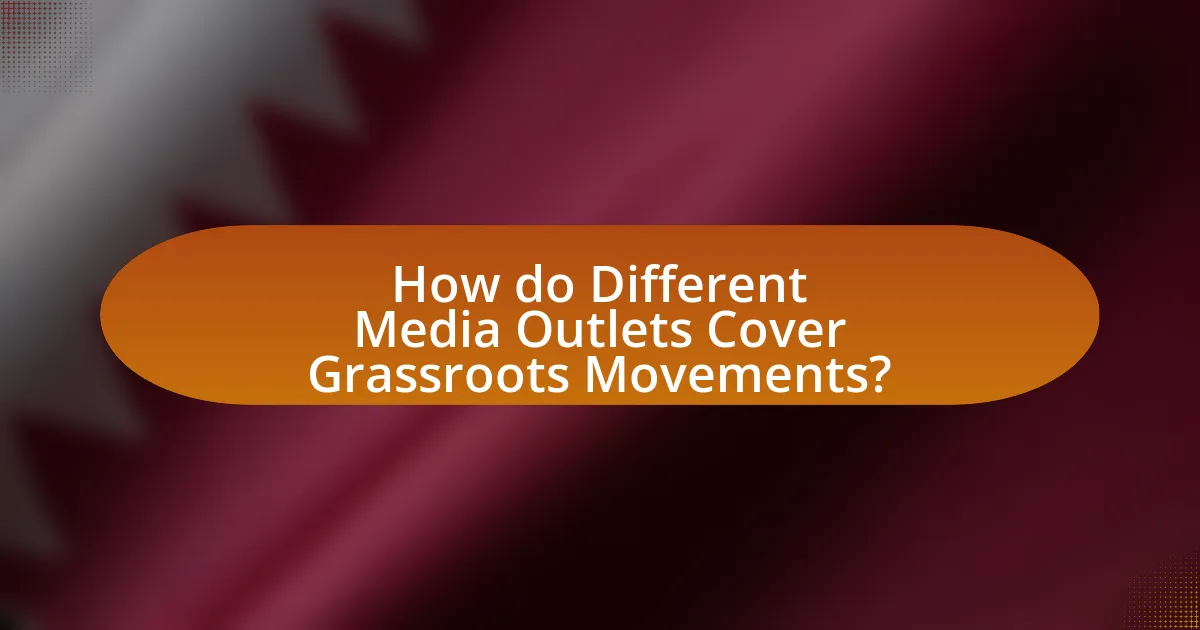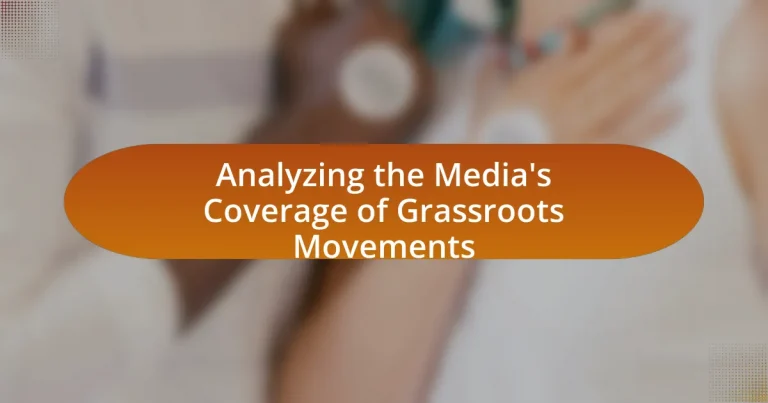The article analyzes the media’s coverage of grassroots movements, emphasizing their significance in social change and community mobilization. It defines grassroots movements as collective actions initiated by ordinary people to address social or political injustices, distinguishing them from top-down movements. The article explores how media coverage influences public perception, mobilizes support, and shapes narratives surrounding these movements, while also addressing the challenges they face in gaining visibility. Key themes include the role of social media, the impact of media biases, and strategies for grassroots movements to enhance their media engagement and storytelling effectiveness.
What is the Media’s Coverage of Grassroots Movements?
The media’s coverage of grassroots movements often highlights their role in social change and community mobilization. Coverage typically focuses on the narratives, goals, and impacts of these movements, showcasing how they challenge established power structures. For instance, the Black Lives Matter movement received extensive media attention, illustrating grassroots activism’s influence on public discourse and policy changes regarding racial justice. Studies indicate that media framing can significantly affect public perception and support for these movements, as seen in the increased visibility and engagement during events like the Women’s March.
How does the media define grassroots movements?
The media defines grassroots movements as collective actions initiated by ordinary people at the community level, aimed at effecting social or political change. These movements often emerge in response to perceived injustices and rely on local engagement and participation rather than top-down directives. For instance, the Civil Rights Movement in the United States is frequently cited as a quintessential grassroots effort, where local activists mobilized communities to challenge systemic racism and advocate for civil rights. This definition is supported by various studies, including those by sociologists like Charles Tilly, who emphasize the importance of local organization and community involvement in the effectiveness of grassroots movements.
What characteristics distinguish grassroots movements from other types of movements?
Grassroots movements are distinguished from other types of movements by their bottom-up approach, community-driven initiatives, and reliance on local participation. Unlike top-down movements, grassroots movements emerge organically from the community level, often addressing specific local issues or injustices. They prioritize the voices and experiences of ordinary individuals rather than established leaders or organizations. For example, the Civil Rights Movement in the United States was largely driven by grassroots activism, with local communities organizing protests and advocating for change, demonstrating the effectiveness of collective action at the community level. This characteristic of grassroots movements fosters a sense of ownership and empowerment among participants, which is less prevalent in movements that are primarily organized by elites or institutions.
How do grassroots movements typically emerge and gain traction?
Grassroots movements typically emerge from a collective response to social, political, or economic injustices experienced by a community. These movements gain traction through the mobilization of individuals who share common grievances, often facilitated by social media platforms that amplify their messages and connect like-minded individuals. For instance, the Black Lives Matter movement gained significant momentum following high-profile incidents of police violence, which galvanized public outrage and led to widespread protests. This demonstrates how specific events can catalyze grassroots organizing, leading to increased visibility and support for the movement’s goals.
Why is media coverage important for grassroots movements?
Media coverage is crucial for grassroots movements because it amplifies their message and increases visibility. When media outlets report on grassroots initiatives, they help to inform a broader audience about the issues at stake, mobilizing support and encouraging public engagement. For instance, the coverage of the Black Lives Matter movement significantly raised awareness of systemic racism and police brutality, leading to widespread protests and policy discussions. This demonstrates that effective media coverage can transform local efforts into national conversations, ultimately influencing public opinion and policy change.
How does media coverage influence public perception of grassroots movements?
Media coverage significantly shapes public perception of grassroots movements by amplifying their visibility and framing their narratives. When mainstream media highlights a grassroots initiative, it can legitimize the movement, attract broader support, and influence public opinion. For instance, the coverage of the Black Lives Matter movement in major news outlets has played a crucial role in raising awareness about systemic racism and police brutality, leading to increased public engagement and policy discussions. Studies show that media framing can affect how audiences interpret the goals and legitimacy of these movements, often swaying public sentiment in favor or against them based on the portrayal of their actions and messages.
What role does media play in mobilizing support for grassroots initiatives?
Media plays a crucial role in mobilizing support for grassroots initiatives by amplifying their messages and increasing visibility. Through various platforms, such as social media, television, and print, media coverage can raise awareness about specific causes, attract public interest, and encourage community engagement. For instance, studies have shown that grassroots movements that receive positive media attention often experience a surge in participation and donations, as seen in the case of the Ice Bucket Challenge, which raised over $115 million for ALS research in 2014 due to extensive media coverage. This demonstrates that effective media engagement can significantly enhance the reach and impact of grassroots initiatives.
What challenges do grassroots movements face in media coverage?
Grassroots movements face significant challenges in media coverage, primarily due to limited access to mainstream media platforms. These movements often lack the financial resources and established networks that larger organizations possess, making it difficult to gain visibility. For instance, a study by the Pew Research Center found that only 27% of local news coverage focuses on community issues, which can marginalize grassroots efforts. Additionally, media narratives may prioritize sensationalism over nuanced reporting, leading to misrepresentation or oversimplification of the movement’s goals and messages. This can result in a lack of public understanding and support, further hindering the movement’s impact.
How do biases in media affect the representation of grassroots movements?
Biases in media significantly distort the representation of grassroots movements by shaping public perception and influencing the narrative surrounding these initiatives. For instance, media outlets may prioritize certain voices or perspectives, often favoring those aligned with mainstream ideologies, which can marginalize the authentic experiences and goals of grassroots activists. A study by the Pew Research Center found that coverage of social movements often reflects the biases of the media’s ownership and editorial policies, leading to underrepresentation of diverse viewpoints. This selective portrayal can result in a skewed understanding of the movements’ objectives, ultimately affecting public support and policy responses.
What are common misconceptions perpetuated by media coverage?
Common misconceptions perpetuated by media coverage include the oversimplification of grassroots movements, portraying them as monolithic entities rather than diverse coalitions with varying agendas. Media often emphasizes sensational aspects, leading to the belief that movements are solely driven by extreme actions or fringe elements, which can distort public perception. For instance, coverage of the Black Lives Matter movement frequently highlights protests and confrontations, overshadowing the broader goals of racial equality and justice that the movement advocates. Additionally, media narratives may suggest that grassroots movements lack organization or leadership, when in reality, many are structured with strategic planning and experienced activists guiding their efforts. This misrepresentation can undermine the legitimacy and complexity of these movements, affecting public support and policy responses.

How do Different Media Outlets Cover Grassroots Movements?
Different media outlets cover grassroots movements by varying their focus, tone, and depth of reporting. Mainstream media often highlights significant events, key figures, and broader implications, while independent and alternative media may provide more in-depth analysis and personal narratives from participants. For instance, during the Black Lives Matter movement, major outlets like CNN and The New York Times reported on protests and policy implications, whereas platforms like Democracy Now! emphasized grassroots voices and local organizing efforts. This divergence in coverage reflects the outlets’ editorial priorities and audience engagement strategies, influencing public perception and understanding of grassroots movements.
What types of media are most influential in covering grassroots movements?
Social media platforms are the most influential types of media in covering grassroots movements. These platforms, such as Twitter, Facebook, and Instagram, enable rapid dissemination of information, allowing grassroots organizations to mobilize supporters and share their messages widely. Research indicates that social media has played a crucial role in movements like Black Lives Matter and the Arab Spring, where hashtags and viral posts significantly increased visibility and engagement. According to a study by the Pew Research Center, 69% of adults in the U.S. use social media, making it a powerful tool for grassroots activism and community organizing.
How do traditional media outlets differ from digital platforms in their coverage?
Traditional media outlets differ from digital platforms in their coverage by primarily offering curated, edited content with a focus on established narratives, while digital platforms provide real-time, user-generated content that allows for diverse perspectives. Traditional media, such as newspapers and television, often adhere to journalistic standards and gatekeeping processes, resulting in a more uniform presentation of news. In contrast, digital platforms like social media enable grassroots movements to share their stories directly, fostering a multiplicity of voices and immediate engagement. For instance, during the Black Lives Matter movement, traditional media coverage often highlighted major protests and key figures, whereas digital platforms allowed activists to share personal experiences and mobilize support rapidly, demonstrating the contrasting nature of coverage between the two mediums.
What impact do social media platforms have on grassroots movement visibility?
Social media platforms significantly enhance the visibility of grassroots movements by providing a low-cost, high-reach medium for communication and mobilization. These platforms enable grassroots organizations to share their messages widely, engage with supporters, and organize events without the constraints of traditional media. For instance, the Black Lives Matter movement gained global attention through social media campaigns, which facilitated rapid dissemination of information and mobilization of protests, demonstrating the power of these platforms in amplifying grassroots voices.
How do media narratives shape the story of grassroots movements?
Media narratives significantly shape the story of grassroots movements by influencing public perception and framing the issues at stake. These narratives determine which voices are amplified, often prioritizing certain perspectives over others, which can affect the movement’s legitimacy and support. For instance, the portrayal of the Black Lives Matter movement in mainstream media has varied from focusing on peaceful protests to highlighting instances of violence, thereby shaping public opinion and policy discussions. Research by the Pew Research Center indicates that media coverage can sway public attitudes, with 70% of Americans stating that news coverage influences their views on social issues. Thus, the way media frames grassroots movements can either bolster their impact or undermine their goals.
What are the common themes found in media narratives about grassroots movements?
Common themes in media narratives about grassroots movements include empowerment, social justice, community engagement, and resistance to authority. Empowerment is often highlighted as grassroots movements enable individuals to take action and influence change, exemplified by movements like Black Lives Matter, which emphasizes the power of collective voices. Social justice themes frequently emerge, focusing on issues such as inequality and discrimination, as seen in coverage of the Women’s March advocating for gender equality. Community engagement is another prevalent theme, showcasing how local organizations mobilize support and foster solidarity, as illustrated by environmental movements like Fridays for Future. Lastly, narratives often depict resistance to authority, portraying grassroots movements as challengers of established power structures, which can be observed in the coverage of protests against government policies. These themes collectively illustrate the multifaceted nature of grassroots movements and their significance in societal change.
How do these narratives affect the movement’s goals and strategies?
Narratives significantly shape grassroots movements’ goals and strategies by influencing public perception and mobilization efforts. For instance, positive media portrayals can enhance a movement’s legitimacy, attracting more supporters and resources, while negative narratives may hinder progress by fostering skepticism or opposition. Research indicates that movements like Black Lives Matter have strategically utilized social media narratives to amplify their messages and engage a broader audience, demonstrating how narrative framing can directly impact strategic decisions and outreach efforts.

What Strategies Can Grassroots Movements Use to Enhance Media Coverage?
Grassroots movements can enhance media coverage by utilizing strategic storytelling, leveraging social media platforms, and building relationships with journalists. Strategic storytelling involves crafting compelling narratives that resonate with the public and media, making the movement’s message more relatable and newsworthy. For instance, movements like Black Lives Matter have effectively used personal stories to highlight systemic issues, capturing media attention.
Leveraging social media platforms allows grassroots movements to disseminate information rapidly and engage directly with audiences, creating a grassroots buzz that traditional media outlets often pick up. The Ice Bucket Challenge is a prime example, where social media virality led to extensive media coverage and increased awareness for ALS.
Building relationships with journalists is crucial; grassroots movements can provide exclusive content, timely press releases, and access to key figures within the movement, making it easier for journalists to cover their stories. Research shows that movements that actively engage with media professionals tend to receive more favorable coverage, as seen in the coverage of the Women’s March, which was bolstered by pre-established media connections.
How can grassroots movements effectively engage with the media?
Grassroots movements can effectively engage with the media by developing clear, compelling narratives that resonate with the public and journalists. These movements should identify key messages that highlight their goals and the impact of their initiatives, ensuring that these messages are concise and relatable. For instance, the Black Lives Matter movement successfully utilized social media to amplify its message, leading to extensive media coverage and public support, as evidenced by the significant increase in news articles and broadcasts during protests in 2020. Additionally, grassroots movements should build relationships with journalists by providing timely information, facilitating interviews, and offering access to events, which can enhance media coverage and foster ongoing dialogue.
What techniques can be used to pitch stories to journalists?
To effectively pitch stories to journalists, utilize techniques such as crafting a compelling narrative, personalizing the pitch, and providing relevant data or statistics. A compelling narrative engages journalists by presenting a clear and interesting story angle that aligns with their audience’s interests. Personalizing the pitch involves addressing the journalist by name and referencing their previous work, which demonstrates familiarity and respect for their expertise. Providing relevant data or statistics strengthens the pitch by offering concrete evidence that supports the story’s significance, making it more appealing to journalists who seek credible and newsworthy content.
How can grassroots movements leverage social media for better coverage?
Grassroots movements can leverage social media for better coverage by creating engaging content that resonates with their target audience, thereby increasing visibility and support. By utilizing platforms like Twitter, Facebook, and Instagram, these movements can share real-time updates, personal stories, and multimedia content that highlight their causes. For instance, the Black Lives Matter movement effectively used social media to amplify its message, resulting in widespread media coverage and public engagement, as evidenced by the over 8 million tweets related to the movement in 2020 alone. This demonstrates that strategic social media use can significantly enhance the reach and impact of grassroots initiatives.
What best practices should grassroots movements follow for media engagement?
Grassroots movements should prioritize building relationships with journalists and media outlets to enhance their media engagement. Establishing trust and open communication channels allows movements to effectively share their narratives and gain coverage. For instance, the 2011 Occupy Wall Street movement successfully utilized social media to connect with journalists, resulting in extensive media attention and public support. Additionally, grassroots movements should craft clear, compelling messages that resonate with their target audience and align with current news trends, as seen in the climate justice movement, which effectively framed its issues within the context of global climate crises. Engaging in proactive outreach, such as sending press releases and organizing media events, further increases visibility and fosters media interest.
How can transparency and authenticity improve media relationships?
Transparency and authenticity can significantly improve media relationships by fostering trust and credibility between media outlets and their sources. When media organizations are open about their processes, intentions, and the information they present, it encourages a more collaborative environment. For instance, a study by the Pew Research Center found that 70% of Americans believe that transparency in reporting enhances trust in news organizations. This trust leads to more reliable information sharing, as sources feel more comfortable providing insights and data, knowing that their contributions will be represented accurately and ethically. Furthermore, authentic communication helps to humanize the media, making it more relatable and accessible, which can enhance engagement with grassroots movements and their narratives.
What role does storytelling play in attracting media attention?
Storytelling plays a crucial role in attracting media attention by creating compelling narratives that resonate with audiences. Effective storytelling humanizes issues, making them relatable and engaging, which increases the likelihood of media coverage. For instance, grassroots movements often utilize personal stories to illustrate their impact, as seen in the coverage of the Black Lives Matter movement, where individual experiences of racial injustice were highlighted, drawing significant media focus. This narrative approach not only captures attention but also fosters emotional connections, prompting journalists to cover stories that reflect societal values and concerns.
What are the key takeaways for grassroots movements seeking media coverage?
Grassroots movements seeking media coverage should prioritize clear messaging and strong narratives to effectively engage journalists. Establishing a compelling story that resonates with the public increases the likelihood of media interest, as evidenced by the success of movements like Black Lives Matter, which utilized powerful personal testimonies to capture attention. Additionally, building relationships with local journalists and leveraging social media platforms can enhance visibility and facilitate coverage, as demonstrated by the viral spread of various grassroots campaigns. Engaging in timely and relevant events also helps to align the movement with current news cycles, making it more appealing to media outlets.


